India's current account deficit narrowed sharply in the first quarter of the year, but the rapidly-falling rupee could threaten the balance going ahead, analysts said.
For the first three months of the year, India's current account deficit narrowed to $18.1 billion or 3.6 percent of GDP, as non-oil and non-gold imports fell due to slowing growth, figures from the Reserve Bank of India (RBI) showed on Thursday.
This compares to the eye popping $32.6 billion, or 6.7 percent of gross domestic product (GDP), recorded in the final quarter of 2012.
But the quick decline of the rupee, which has been one of the world's worst performing currencies over the past month, could threaten to widen the current account gap going forward,as capital continues to flow out.
(Read More:
Diving Rupee—Here's How Bad It Can Get for India
)
Vishnu Varathan, market economist at Mizuho Bank, described the narrowing deficit as a "fleeting relief."
"How hollow a relief it will be remains to be seen. The second quarter is likely to look worse than the first if nothing changes from now," he said.
The current account deficit for the full financial year ended March 2013 was at a record high 4.8 percent of GDP.
(Read More: Why Market Watchers Aren't Giving Up on India )





